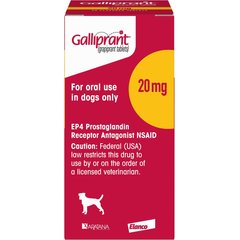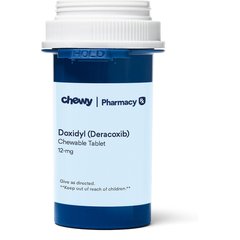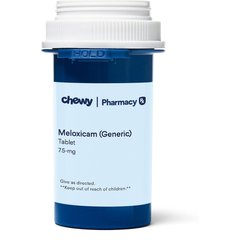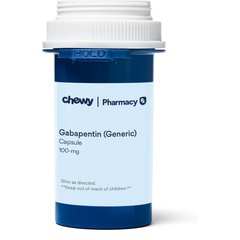Osteoarthritis in Dogs: Symptoms, Causes, and How To Help Your Dog
Chalabala/iStock / Getty Images Plus via Getty Images
What Is Osteoarthritis in Dogs?
Osteoarthritis in dogs refers to the breakdown of joints as dogs age. This chronic disease occurs in roughly 25% of dogs, is irreversible, and is most common in senior pets.
Dogs with osteoarthritis lose cartilage (the soft tissue that cushions the joint) over time. They can also develop small bony pieces within the joint that can cause pain and swelling in the affected leg.
Most cases of osteoarthritis in dogs occur as secondary conditions to diseases such as hip dysplasia and elbow dysplasia.
Other risk factors of osteoarthritis in dogs include body weight, obesity, sex, amount of exercise they get, and diet.
Symptoms of Osteoarthritis in Dogs
A pet parent will usually notice signs of osteoarthritis in dogs.
Most commonly, dogs will show:
-
Decreased willingness to play or exercise, as well as decreased energy in overall activity
-
Stiffness or lameness, such as a difficulty moving from sitting to standing
-
A change in their posture and gait
-
Shifting legs when walking
-
Swollen joints
Dogs may try to protect themselves from pain by developing a bunny hop walk (when both back legs are held tightly together, hopping like a rabbit), sit in a way to leave the painful area extended, or overall appear weak.
They may also limp when walking.
Causes of Osteoarthritis in Dogs
Osteoarthritis in dogs is classified as primary or secondary.
Primary osteoarthritis in dogs tends to be idiopathic (with an unknown cause) or associated with aging.
Secondary osteoarthritis in dogs refers to the condition occurring because of another condition, such as:
-
Injury
-
Hip or elbow dysplasia
Age and weight play a factor in the development of osteoarthritis in dogs. Osteoarthritis is a progressive condition, which means the joints continue to deteriorate as the dog ages.
How Veterinarians Diagnose Osteoarthritis in Dogs
Osteoarthritis in dogs is diagnosed through a physical exam and imaging.
Typically, veterinarians start by observing the dog’s walking, trotting, and running patterns.
During the physical exam, a vet will feel for swelling or effusion (excess fluid in the joint) and note any decreased range of motion in a dog’s joints.
Your vet will check for thickening around the joint, crepitus (rubbing and friction of bone and cartilage), or muscle atrophy (wasting away) in muscle size between similar joints.
The exam may be done with your dog sedated to prevent pain.
In addition to a physical exam, your vet may recommend:
-
Radiographs (X-ray)
-
Blood work, if medication is to be prescribed
-
Joint fluid analysis to rule out infection or, in some cases, cancer
-
Imaging tests, such as CT or MRI
-
Force plate gait analysis, which measures the force exerted between a paw and the ground when walking or standing still
-
Endoscopy of the affected joints, using a specialized thin tubing with a tiny camera and instruments that can visualize and sometimes treat problem areas
Treatment of Osteoarthritis in Dogs
Commonly prescribed therapies include:
- NSAIDs to decrease inflammation and pain: Common drugs include Galliprant®, carprofen, deracoxib, firocoxib, meloxicam, and others. These drugs can have side effects and not all dogs can tolerate them. Your veterinarian will recommend the best choice for your dog.
- Supplements: Such as omega 3 fatty acids, glucosamine/chondroitin, and other natural anti-inflammatory products.
- Steroids: Such as prednisone, methylprednisolone, and triamcinolone. Steroid medications can have many side effects and must be handled carefully.
-
Other pain medications that work with NSAIDs or through a different approach: These include gabapentin, tramadol, and amantadine.
-
Adequan®: An injectable prescription product that has anti-inflammatory effects.
-
Many dogs experience significant comfort and minimal side effects with the use of Adequan® as part of their pain reduction plan.
-
-
Librela™: An injectable prescription monoclonal antibody that is given once monthly for pain.
Over-the-counter medications and supplements may be prescribed for osteoarthritis in dogs.
Always follow your veterinarian's guidance carefully when it comes to giving prescription medications. These medications can have serious side effects if given inappropriately.
Alternative therapies may be helpful for osteoarthritis in dogs.
These include acupuncture, laser therapy, and physical rehabilitation including hands on techniques and therapeutic exercise, such as massage and stretching.
Chiropractic manipulation and stem cell therapy have also been helpful for some dogs. There has been some promising research and individual success stories regarding these therapies.
In some cases, surgery—such as a total hip replacement or femoral head and neck ostectomy—may be recommended to limit pain associated with inflammation.
Recovery and Management of Osteoarthritis in Dogs
Your veterinarian may suggest lifestyle changes for a dog with osteoarthritis.
Weight loss and management is essential to reduce inflammation and stress on the joints.
A vet may suggest a prescription diet along with regular exercise, when the dog is able to tolerate movement.
Short walks, stretching, and swimming are good exercise options for dogs with osteoarthritis.
Some dogs may also benefit from supportive knee or back braces if recommended by their vet.
If your vet recommends surgical intervention, a rehabilitation and physical plan will be prescribed. This often includes:
-
Rehabilitation
-
Physical therapy
-
Massages
-
Swimming
Dogs with osteoarthritis can live long, happy lives if their condition is well-managed with medications and supportive care.
This condition should not shorten the dog's life, but it can cause significant discomfort if not treated appropriately. Pet parents should ensure they watch their dogs closely for signs of pain and speak with a veterinarian to determine the best course of action.
Pet parents should always speak with their veterinarians before creating their own treatment plans for their dogs.
Prevention of Osteoarthritis in Dogs
It’s difficult to prevent osteoarthritis in dogs since normal wear and tear on the joints contributes to the disease.
However, pet parents can proactively start their dogs on joint supplements or a dog food containing glucosamine and chondroitin to support healthy joints and slow the development of osteoarthritis.
Osteoarthritis in Dogs FAQs
How long can a dog live with osteoarthritis?
A dog can live a normal lifespan with osteoarthritis if the pain and inflammation are well-managed with medication and supportive care.
What is the best pain relief for dogs with arthritis?
The best pain relief for dogs with arthritis is non-steroidal anti-inflammatories (NSAIDs) because they target pain and inflammation.
Should a dog with arthritis be walked?
A dog with arthritis can be walked for short distances to encourage mobility and light exercise.
References
-
American College of Veterinary Surgeons. Osteoarthritis in Dogs.
-
Pavolovsky Gene DVM, VINcyclopedia of Diseases. Degenerative Joint Disease (Canine).
-
Brooks, Wendy DVM. “Medications for Degenerative Arthritis in Dogs and Cats.” Veterinary Partner, 10 Sept. 2001, veterinarypartner.vin.com/default.aspx?pid=19239&catId=154455&Id=4951467.
-
Riley, Elizabeth. “Physical Rehabilitation for Arthritis in Dogs.” Veterinary Partner, 8 Feb. 2021, veterinarypartner.vin.com/default.aspx?pid=19239&catId=102899&id=10076165&ind=238&objTypeID=1007.







